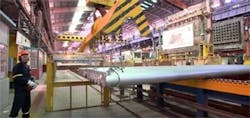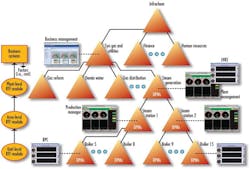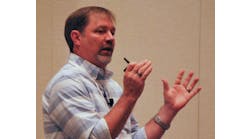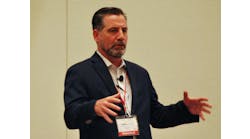Surveys and granularity
To determine the most useful hardware and software for energy efficiency, several sources recommend performing good ol' site surveys, using submetering for individual applications and devices, establishing energy accounting centers (EAC), and using other low-tech methods.
"The first step is an audit of what you're doing today, which includes current baseline practices and best practices," says Synergy's Urda. "Old systems may have some poor operations in place, but they often haven't been or can't be characterized, so users don't know where to add economizers or VFDs. We often see steam areas treated like a red-headed stepchild, even though plants that make everything from steel to cookies couldn't make anything without the unglamorous support utilities they've been overlooking for 20-30 years. There's great potential for savings here.
"For example, as part of our factory acceptance tests (FAT), we sit with the software that's easier to use, and doing low-fidelity simulation, which is just turning systems on and off to see how they run. The fanciest we get is the work we've been doing with U.S. Steel to implement laser combustion analysis to optimize reheating furnaces, which usually have five different fired zones and six to 10 burners per zone. Laser sensing allow us to traverse each zone, and provides an average energy measurement for each one. This lets us see if any individual zone is misbehaving."
Emerson's Sabin adds that users can divide a facility or application into EACs that are as big or small as make sense to them and their energy-efficiency effort. "You can start small with just a couple of units such as a heater or distillation column, and get your required measurements," says Sabin. "Then you can look at your process and P&ID diagram, find other measurements, get them up to your historian, add real-time performance monitoring, and do calculations to compare real versus theoretical performance, which will show where you need to improve. In this case, you can have you cake and eat it, too, with easier operations, hitting your production benchmarks, and having great energy performance—all at the same time. Plus, since the tools are easier, maybe you don't have to keep putting up with that broken transmitter that you didn't have the time or budget to fix before."
Implementing intelligence
While more-effective, better-applied hardware can save a lot of power, some of the greatest potential energy-efficiency gains are emerging as many process components also gain the microprocessors and software to gauge their performance and the network connections to let users know about them in real-time or close to it—fueling and enhancing those much-sought better decisions.
RoviSys' Suhwail adds, "Just 10 years ago, the hardware previously installed in most substations was electromechanical, and we couldn't communicate with it. Since then, much of it's been replaced by relays with onboard microprocessors that we can talk to, and this has opened levels of monitoring and control via PLCs that we never had before."
To give users the process/power control solutions they need, RoviSys writes functional specifications and controls software based on their individual priorities. "Efficiency often comes from many processes that weren't controlled before, plus the value to be gained from better tuning, which applies to some applications and industries more than others," says Suhwail. "It's like balancing a checkbook—you start to save as soon as you look at it because doing so immediately changes attitudes, identifies bad actors, or shows how equipment can be better utilized."
Melissa Topp, senior global marketing director at Iconics, adds that, "Organizations looking to become more energy efficient must ensure that they can first monitor and manage the equipment involved in their business operations (manufacturing, etc.) as well as their facility operations. On the facility side, this may involve a wide number of meters (including those for electricity, gas, fuel oil, steam, or chilled water). Once all possible connections are made, data from these now-connected devices can be fed into comprehensive energy management and analysis software, such as Iconics Energy AnalytiX off-the-shelf software, which can be implemented quickly to provide users with custom energy-related dashboards. It can be deployed quickly, and often helps lead to 5-25% savings on annual utility bills.”
Simulation, APC save with digital
While process modeling and classic simulation haven't been synonymous with energy efficiency, their relationship is getting closer thanks to digitalized technologies, Ethernet and Internet networking, and analytics on servers and cloud services.
Sabin adds that an EMIS, such as Emerson's Energy Advisor, lets users pick a point in time when their application was running optimally; push a button to make a model that knows the relationships between points in the process that affect energy performance, and set up alerts when preset targets for those optimal operations aren't met. "Every supplier has an EMIS and many customers used them with spreadsheets, but that's how it's been done in the past, and doesn't allow real-time performance improvements," explains Sabin. "Today's performance models are based on the historical model for my application and plant. This isn't really APC using first-principles, but those were for very complex operations and not many sites could do it. Now, many APC tools are getting easier to use, and we can build a model and run an optimization scenario in 15 minutes, and tell the boiler or co-generation facility where to go for the best performance."
Because even a relatively stable fuel like natural gas can vary by up to 10% in energy content per volume over time, Sabin adds that Emerson recently developed an advanced control for combustion processes as part of its Smart Process program that can adjust in real-time for changes in a user's fuel stream. "Combustion systems have to run stably for years," says Sabin. "That's why we're trying get them into real-time control. Model-based control and APC aren't the same, but they're looking more like each other, using similar tools built right along with regulatory control, and doing calculations that used to take hours and minutes in a heartbeat."
Similarly, one of Votorantim Cimentos' plants in Rio Branco do Sul, Paraná, Brazil, launched a new cement production line in 2013, but after operating for about one year, the company asked ABB to use APC to optimize the line. As a result, ABB deployed its Expert Optimizer 8.0 software that facilitates optimization, enables commissioning without stopping the plant, and retains the freedom of human interaction in the system.
Expert Optimizer uses two APC methods, including fuzzy control and MPC. Its installation topology allows it to be deployed in ABB control systems and in third-party controls, and following implementation in individual areas, it creates connections between them so optimization can occur systemwide. At the Votorantim plant, it was deployed on a vertical raw mill, ball coal mill, kiln, calciner, cooler and two cement mills. The mills were commissioned with MPC, and kiln calciner and coller were commissioned with fuzzy control.
Figure 3: Aluminum of Greece's plant in Agios Nikolaos, Viotia, is adopting a "digital smelting" solution based on GE Power's Predix industrial Internet platform, which will use virtual sensor data to evaluate temperature and chemical parameters not usually monitored continuously, recreate an actual smelter with artificial intelligence and physic-based models, reduce the plant's power and raw material consumption, and predict pot leaks.
Source: AOG and GE
“The cement mill’s productivity gain had a positive impact that reflected an overall reduction of 1.15 kWh/t of energy consumption,” says Bruno Marin, production manager at Votorantim Cimentos. Individual equipment benefits generated by Expert Optimizer at the Brazilian cement plant included: 62% reduction in raw mill power consumed; 60% reduction in raw mill bed depth; 24% reduction in kiln motor load; 27% reduction of free lime; 16% reduction in liter weight; 5% reduction in burning zone temperature; and reduced consumption of grinding media in the ball mill.
Likewise, GE Power and Aluminium of Greece S.A. (AOG) in Athens, recently agreed that three global GE teams will develop "digital smelter" solutions to enhance AOG's smelting process by reducing energy and aluminum fluoride consumption, and predicting pot leaks at its plant in Agios Nikolaos, Viotia, Greece (Figure 3). As a division of Mytilineos Group (www.mytilineos.gr), AOG is reported to be the largest vertically integrated producer of bauxite, alumina and aluminum in the European Union (EU).
These digital smelter solutions will use GE's Predix industrial Internet platform and software. The partners report that "virtual sensors" will facilitate the ongoing evaluation of parameters such as temperature and chemistry that aren't usually monitored continuously, which will help anticipate pot condition and health, and provide timely monitoring reports on the plant operations. “We'll recreate an actual smelter using artificial intelligence (AI) and physics-based models,” explains Bhanu Shekhar, chief digital officer for GE Power in the Middle East and Africa. “This is a living digital model that will continuously generate smelter data, and will help address the challenges of power usage and the consumption of raw materials in the smelting industry.”
Nova's Anderson cautions that simulation may be able to aid energy efficiency, but it will also have to show potential users that it can pay for itself. "If you're building a new greenfield application or facility, simulation can make sure it's done correctly," he says. "However, if you're dealing with an ongoing process, people will ask why use simulation when they can walk the floor, and see directly if a process is running efficiently? Our users, especially the smaller ones, want to know how they're supposed to recoup these costs."
Advanced, alternate combinations
Logically, once hardware, microprocessors, software, networking, digitalization, the Internet and the cloud really meld, they're expected to deliver unified process and power efficiencies way beyond what they could achieve separately.
For example, to fend off commodity cost pressures in its chemical and energy businesses, Sasol Corp. in Johannesburg recently enlisted Schneider Electric to help monitor power consumption and costs in real-time, so operators, engineers and managers at its Sasol One plant in Sasolburg, South Africa, could identify energy needed for operations, optimize usage, and minimize impact on the local grid. This facility draws process water from a nearby river to make steam in two stations and an automatic thermal reformer area that's used for internal and external consumption, and the water is treated at one plant and mixed with condensate recovered from others. The stations are required to operate with 160 tons per hour of spare steam, which can be costly if the plant can't meet demand for steam and must reduce supply to electricity customers who buy from the grid.
After considering these challenges and conducting a plant operation and strategy audit, Sasol One's personnel and Schneider Electric's Business Consulting Team collaborated to develop real-time dynamic performance measurements (DPM) for the facility's Steam Plants 1 and 2, which are each controlled by a dedicated distributed control system (DCS), historian and HMI, and communicate with the IT layer via bidirectional networking. Modeled in the DCS, DPMs and algorithms were created for each boiler, steam station and steam generation area in the two plant, and three station-level DPMs were developed for steam cost, quality and production rate (Figure 4).
Figure 4: Sasol and Schneider Electric developed dynamic performance measures (DPM) for two steam stations at the Sasol One plant in Sasolburg, South Africa, implemented DPMs and dashboards, and saved 4% on electricity and 6% on overall energy in the first month, or about $230,000, and expects a 2% annual reduction variable costs such as electricity and energy feedstocks.
Source: Sasol and Schneider Electric
The DPMs and real-time financial metrics combined in management and operator dashboards to aid decision-making, which produced a 6% overall energy savings and 4% electricity savings in the two steam stations during the first month. This translated to a $230,000 savings in the first month, $400,000 saved over the first two months, and an estimated reduction of 2% reduction in variable costs per year that's already been surpassed.
Iconics' Topp adds, "“Energy efficiency and management solutions are currently moving to a cloud-based, software-as-a-service model, uncovering access to the additional benefits that a cloud/IIoT approach can provide. These include increased scalability (due to the ability to securely access multiple locations via cloud platforms such as Microsoft Azure); reduced hardware obsolescence (in that the heavy lifting of processor-intensive analysis can be performed offsite); and expanded connectivity of various equipment (as more devices will now be able to communicate via shared IoT transport protocols).
"Iconics recently introduced its Smart Energy AnalytiX solution, which provides a comprehensive, secure cloud-based energy analysis platform. Customers who opt to use this subscription-based offering can save on traditional costs associated with data center infrastructure and IT staff expenses, while ultimately saving even more by reducing energy use and adhering to proactive maintenance practices.”







